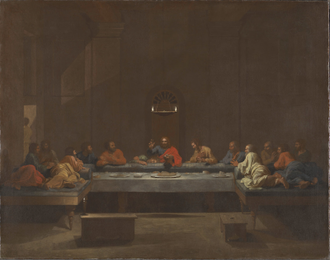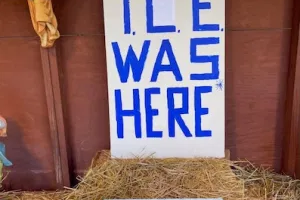National Gallery acquires Poussin's Eucharist

Eucharist by Nicolas Poussin. National Gallery
Source: National Gallery
The National Gallery has acquired, in time for Easter, Eucharist (about 1637-40), one of the greatest paintings of the Last Supper, by Nicolas Poussin (1594-1664). The painting is the first of the Gallery's Bicentenary year acquisitions.
It can be viewed in Room 31 from today alongside a new long loan from the same Sacraments series Marriage (about 1637-40).
The 15th painting by the French classicising artist to enter the Gallery's collection, Eucharist is part of Poussin's revolutionary cycle of the Seven Sacraments.
It has been acquired through a hybrid* Acceptance in Lieu from the Trustees of the Duke of Rutland's 2000 Settlement with the support of a generous legacy from Mrs Martha Doris and Mr Richard Hillman Bailey, 2023.
The picture is one of a cycle of seven scenes Poussin painted, in the second half of the 1630s, showing the Catholic Sacraments, for his friend and patron, the Roman antiquarian Cassiano dal Pozzo (1588-1657): Baptism, Penance, Eucharist, Confirmation, Marriage, Ordination and Extreme Unction. The sacraments are Christian rites through which divine grace is communicated to human beings. Poussin illustrated them with biblical and early Christian imagery. The series was brought to Britain in 1785 where Sir Joshua Reynolds, founding President of the Royal Academy, declared 'The Poussins are a real national object.' The series was so successful that a second suite of sacraments was commissioned from Poussin in the late 1640s by the French collector Paul Fréart de Chantelou (1609-1694). That second series is on loan to the National Galleries of Scotland.
Six paintings remain from the first series of Sacraments, Penance having been destroyed by fire in 1816. Baptism was acquired by the National Gallery of Art, Washington DC in 1939; Ordination by the Kimbell Art Museum, Fort Worth in 2011; and Extreme Unction by The Fitzwilliam Museum, Cambridge in 2013. In January 2023, an export licence was issued for Confirmation, which was sold abroad. Eucharist and Marriage remained in the collection of the Trustees of the Duke of Rutland's 2000 Settlement.
Poussin represents the sacrament of Eucharist with a depiction of the Last Supper. At the centre of the strikingly symmetrical composition is Christ holding the bread and cup of wine in one hand and raising the other in blessing. He is seated at a Roman triclinium, a padded couch whose cushions and bolsters Poussin has decorated with a delicate pattern. There are six disciples on either side. At far left, a shadowy figure retreats through an open door, creating a sense of movement in an otherwise still scene. Judas is probably the figure second from the left, the only disciple who does not turn towards Christ.
The most striking feature of this painting is its dramatic use of light, which comes from three sources: the two flames of the double-wicked lamp above Christ's head and the candle on the stool in the centre left foreground. With these multiple light sources, Poussin sets in motion a complex play of shadow projection, with elements casting two or even three shadows.
Eucharist has been executed with Poussin's characteristic precision. A pinpoint hole can easily be made out in the fanlight window above Christ's head, used by the artist to plot the picture's perspective. In the foreground, the grid of floor tiles has been rigorously planned, and may suggest the use of Poussin's grande machine (a large box, rather like a toy theatre, into which Poussin placed wax figurines to devise and stage his compositions). Near the right-hand stool, we can see where Poussin has scraped away paint with the end of his brush. Although the painting is not minutely detailed, the blocks of light and shadow in the figures, particularly the faces and feet of the disciples on the right, give a vivid sense of how he worked up his composition. Poussin has paid a great deal of attention to the rhythm of the disciples' hands across the picture, several of which are held up to receive Christ's blessing.
On loan to the Gallery and displayed close to Eucharist is Marriage from the same series and on loan from the collection of the Trustees of the Duke of Rutland's 2000 Settlement. Poussin illustrated the Sacrament of Marriage by showing the betrothal of the Virgin Mary to Joseph. Poussin depicted Joseph placing the ring on the Virgin's finger. Joseph still holds the flowering rod, which had distinguished him from the other men as the most appropriate suitor for Mary.
The decision to depict the seven sacraments was almost unprecedented in painting. The commission speaks to Poussin's extraordinary formal inventiveness, and to the intellectual circle around Dal Pozzo and its fascination with the history of the early Church. In Eucharist, the prominent and precisely described triclinium encapsulates Poussin's sustained effort to paint an archaeologically accurate interpretation of the events.
Dr Francesca Whitlum-Cooper, Acting Curator of Later Italian, Spanish and French Paintings, says: "The National Gallery has one of the greatest collections of Poussin's paintings in the world. Our collection is comprehensive, comprising early works and late, classical mythologies, landscapes and religious scenes. We were not able, until now, to show any of the Seven Sacraments, the single most important commission of Poussin's career. Acquiring Eucharist not only broadens and deepens our representation of Poussin: it also means that one of the pictures from the most beautiful and important series of paintings in the Western canon now hang on our walls."
National Gallery Director, Dr Gabriele Finaldi, says: "Poussin's Eucharist is an impressive and austere masterpiece. It is the first of the National Gallery's Bicentenary year acquisitions and we are grateful to HM Government, the Acceptance in Lieu panel at the Arts Council, and the generosity of Mrs Martha Doris Bailey's legacy, for enabling the painting to join the nation's collection."
Michael Clarke CBE, Chair, Acceptance in Lieu Panel, said: "I am delighted that Eucharist by Nicolas Poussin has been acquired by the National Gallery through the Acceptance in Lieu Scheme under a hybrid agreement funded by the Gallery. It comes from one of the most important sets of paintings in the history of Western art, the series of the Seven Sacraments that Poussin painted around 1638-42 for his major patron, the scholar and collector Cassiano dal Pozzo. The sacraments are the religious mysteries of the Christian Church. In this instance Eucharist is illustrated by the biblical episode of the Last Supper that Christ shared with his 12 disciples. The painting will greatly enhance the National Gallery's major holding of works by Poussin, and I hope that this example will encourage others to use the Scheme and continue to support our national collections."
Arts and Heritage Minister Lord Parkinson of Whitley Bay, said: "This acquisition of Poussin's Eucharist is doubly timely, not only as the National Gallery begins to celebrate its Bicentenary, but as millions of people across the world prepare to mark the sacrament depicted in it during the Holy Week of Easter. As it approaches its 200th birthday, the National Gallery continues to provide the public with world-leading, life-changing cultural experiences, supported by vital schemes such as Acceptance in Lieu - I hope this shining example will help to attract ever more visitors to the gallery, and encourage more institutions to make use of the scheme."
Nicolas Poussin (15 June 1594 - 19 November 1665) is arguably the single most important French painter before Manet and the Impressionists in the 19th century. A native of Normandy, Poussin undertook some artistic training in Paris, but quickly fixed his sights on Italy. He reached Rome (on his third attempt) in 1624 and, bar one unwilling return to Paris as painter to King Louis XIII in 1640-42, remained in the Eternal City for the rest of his life.
Poussin eschewed the large altarpieces and religious commissions that drew so many of his contemporaries to Rome. Instead, he produced smaller gallery pictures - history paintings, religious scenes and, from the 1640s, landscapes - for a select handful of collectors and connoisseurs. He was deeply interested in the classical world, taking inspiration from both antique sculpture and the masterpieces of artists such as Raphael (1483-1520) and Titian (active about 1506; died 1576) that were accessible to him in Rome. His paintings are noted for their meticulous execution and for their erudition, often drawing on classical sources.
Enthusiastically collected by his compatriots and promoted after his death as the father of French painting, Poussin's works have influenced artists as diverse as Jacques-Louis David (1748-1825), Paul Cezanne (1839-1906), Pablo Picasso (1881-1973) and Francis Bacon (1909-1992). He is undoubtedly one of the canonical figures of the Western tradition whose works, as our recent exhibitions George Shaw: My Back to Nature (2016) and Poussin and the Dance (2021) have shown, continue to inspire artists today.
The National Gallery is one of the greatest art galleries in the world. Founded by Parliament in 1824, the Gallery houses the nation's collection of paintings in the Western European tradition from the late 13th to the early 20th century. The collection includes works by Artemisia Gentileschi, Bellini, Cezanne, Degas, Leonardo, Monet, Raphael, Rembrandt, Renoir, Rubens, Titian, Turner, Van Dyck, Van Gogh and Velázquez. The Gallery's key objectives are to care for and enhance the collection and provide the best possible access to visitors. Admission free.
On 10 May 2024 the National Gallery will be 200 years old, and will start their Bicentenary celebration, with a year-long festival of art, creativity and imagination, marking two centuries of bringing people and paintings together.
LINK
National Gallery: www.nationalgallery.org.uk


















